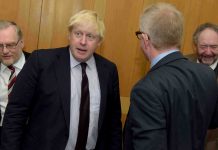The Asian View with Bushra Irfan
No matter what a person’s opinion is on the above, one thing is quite clear – President Musharraf was a most unusual person.
Even though he took over rule on a military coup on Nawaz Sharifs government in 1999, he showed great political and democratic prowess which is most unusual for a man with his military background.
And, of course, most unusual of all for Pakistan political leaders, he managed to leave the government, although on the verge of an impeachment, unscathed without any serious allegations of corruption against him.
President Musharrafs rule has been one fraught with extreme difficulties which even democratically elected leaders would have found difficulties in resolving. However, President Musharraf managed to resolve them politically and on the most part effectively.
When he took over, the war between India and Pakistan was on a brink and could have become a nuclear war. The armed attack on the Indian Parliament in 2001 was an escalating factor. However, President Musharraf changed his policy from war to a long peace process from 2004 onwards with India.
He encouraged female participation in Parliament and was instrumental in women empowerment and modernising many sectors of Pakistani society. He improved education and people saw an improvement in roads and hospitals.
However, when he agreed to become a staunch ally with America in the so called War on Terror after September 11th, he became increasingly unpopular with the people who felt he was betraying them to fight a war for America. In exchange for his concerted efforts to assist America he received more than £10 billion pounds in aid for the Pakistani army although this brought a great result and unrest in the country itself
The interaction with the people in incidents such as the Lal Mosque only went to further his growing unpopularity and the last straw for the people came when the middle class lawyers all turned out in the streets protesting when he sacked the Chief Justice. Matters then ultimately went from bad to worse when he eventually imprisoned about 60 Judges and many lawyers. He then imposed a State of emergency in an effort to retain the Presidency.
However, as stated earlier we do have to accept the fact that at least he has not had any allegations for corruption against his government which neither of the two leaders of the main Democratic parties, namely the Pakistani People Party (PPP) and the Pakistan Muslim League – Nawaz (PML-N) can boast about.
The alliance of the two aforementioned parties in February did lead to the threat of impeachment and the subsequent resignation of President Musharraf.
But what does the future hold for a country which has been described by the Foreign Policy Magazine in US which published its 4th annual “terrorist index” by over 100 terrorist experts as being the country most likely to become the next Al-Qaeda stronghold? 69% of the experts consider Pakistan as the country most likely to transfer nuclear technology to terrorists.
To make matters more difficult after the resignation of Musharraf, the country was left with an unstable coalition of the two main parties PPP and PML-N. True to form and as expected, the coalition broke up over the issue of how to release the Judges.
Eight of the 60 judges have been released today with more on the way by the PPP who are hopeful that Mr Zardari will become the next President of Pakistan.
So what will happen to Pakistan? With difficult issues facing the new government of a possible economic meltdown and the growing militant threat in the North West tribal areas bordering Afghanistan, and the history of the current leaders, who knows? Anything is possible.




































